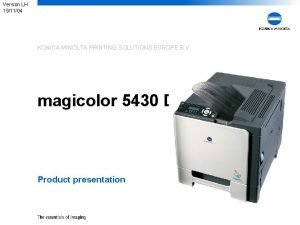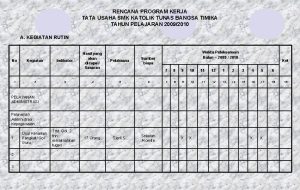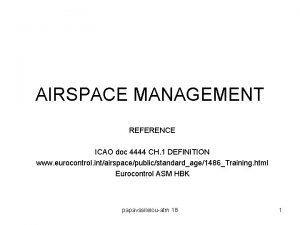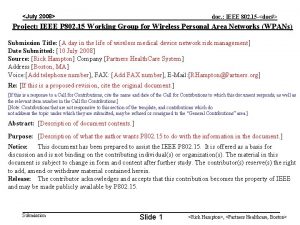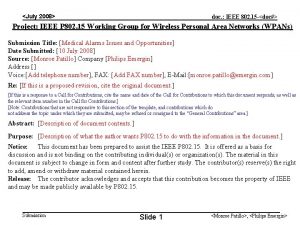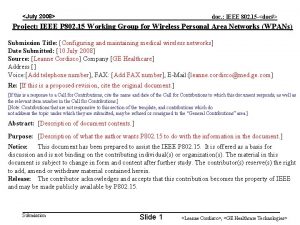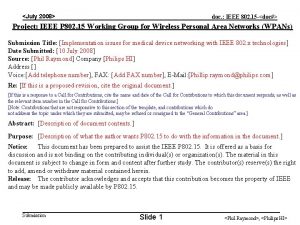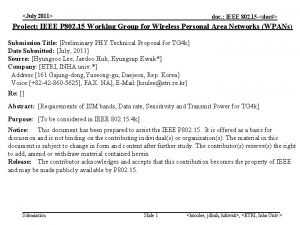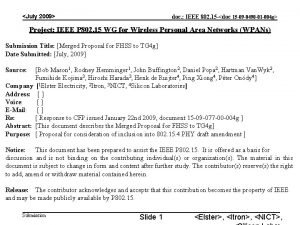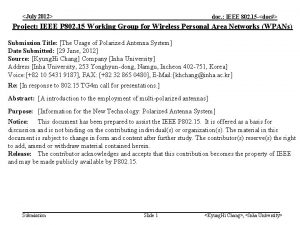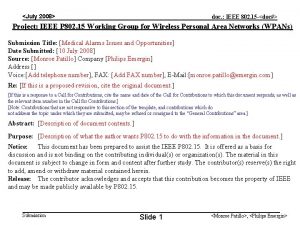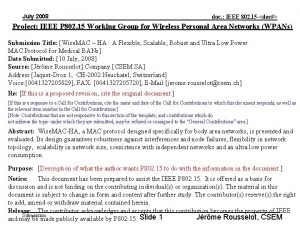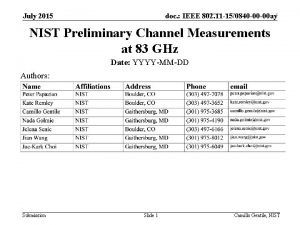July 2019 doc IEEE 802 11 191104 r








![July 2019 doc. : IEEE 802. 11 -19/1104 r 1 References [1] I. Sarris, July 2019 doc. : IEEE 802. 11 -19/1104 r 1 References [1] I. Sarris,](https://slidetodoc.com/presentation_image_h2/5938519ad168a146d56a5df15b992da2/image-9.jpg)




- Slides: 13

July 2019 doc. : IEEE 802. 11 -19/1104 r 1 NGV PHY Performance Results Date: 2019 -07 -16 Authors: Submission Slide 1 Ioannis Sarris, u-blox

July 2019 doc. : IEEE 802. 11 -19/1104 r 1 Abstract This contribution presents an update to the open source 802. 11 p/bd simulation model which now includes some of the potential features of the NGV PHY. Additionally, results from performance investigations using this model are presented and discussed. • Open source 802. 11 p model [1] available at: • https: //github. com/u-blox/ubx-v 2 x/ • Branch with potential NGV features available at: • https: //github. com/u-blox/ubx-v 2 x/tree/ngv Submission Slide 2 Ioannis Sarris, u-blox

July 2019 doc. : IEEE 802. 11 -19/1104 r 1 Introduction The ubx-v 2 x model was updated with the following (potential) NGV features: • • • LDPC encoding / decoding LDPC tone mapping / demapping Midamble insertion / tracking 802. 11 ac DC 2 20 MHz numerology MCS 8: 64 -QAM 5/6 MCS 9: 256 -QAM 3/4 Submission Slide 3 Ioannis Sarris, u-blox

July 2019 doc. : IEEE 802. 11 -19/1104 r 1 Performance investigations • Three PHY configurations: 1. 2. 3. Standard 802. 11 p @ 10 MHz with DACE [2] NGV PHY* with BCC & DACE NGV PHY* with LDPC & MCE * NGV PHY assumptions: • • Submission 802. 11 ac, 20 MHz DC 2 numerology MCS 0 -7 (standard 802. 11 p) MCS 8: 64 -QAM 5/6 MCS 9: 256 -QAM 3/4 Slide 4 Ioannis Sarris, u-blox

July 2019 doc. : IEEE 802. 11 -19/1104 r 1 Simulation parameters • Payload length: 400 bytes • DACE (applicable to PHY #1 & PHY #2): • Viterbi TB = 96 bits • Latency = [5, 4, 3, 3, 2, 2, 2] OFDM symbols for MCS 0 to 9 respectively • Channel models [3, 4]: • Rural Lo. S (144 km/h, low frequency selectivity) • Highway NLo. S (252 km/h, high frequency selectivity) • Doppler is Asymmetric Jakes (C 2 C definition) • Impairments: • AWGN • CFO: U(-5, 5) ppm on both Tx and Rx Submission Slide 5 Ioannis Sarris, u-blox

July 2019 doc. : IEEE 802. 11 -19/1104 r 1 Rural Lo. S Performance Low SNR (ρ < 10 d. B) range • • NGV BCC marginally better than legacy NGV LDPC marginally worse than legacy Mid SNR (10 d. B < ρ < 20 d. B) range • NGV BCC/LDPC better than legacy High SNR (ρ > 20 d. B) range • NGV BCC/LDPC significantly better than legacy • NGV LDPC would probably benefit from an even higher MCS (eg. QAM-256, 5/6) Submission Slide 6 Ioannis Sarris, u-blox

July 2019 doc. : IEEE 802. 11 -19/1104 r 1 Highway NLo. S Performance Low SNR (ρ < 10 d. B) range • NGV BCC/LDPC similar performance to legacy Mid SNR (10 d. B < ρ < 20 d. B) range • • NGV BCC marginally better than legacy NGV LDPC worse than legacy High SNR (ρ > 20 d. B) range • • NGV BCC significantly better than legacy NGV LDPC on average similar to legacy Submission Slide 7 Ioannis Sarris, u-blox

July 2019 doc. : IEEE 802. 11 -19/1104 r 1 Conclusions • An updated MATLAB model was presented which can be used as a basis for link-level NGV simulations • As in previous studies, performance studies showed that there are many cases where the (BCC + DACE) PHY provides significant gains against an (LDPC + MCE) PHY • Irrespective of the FEC / channel tracking method throughput improvements were confirmed for: • higher modulation schemes (eg. 256 -QAM) • higher coding rates (eg. 5/6) • extended numerology (eg. 11 ac 10 MHz DC 2) Submission Slide 8 Ioannis Sarris, u-blox
![July 2019 doc IEEE 802 11 191104 r 1 References 1 I Sarris July 2019 doc. : IEEE 802. 11 -19/1104 r 1 References [1] I. Sarris,](https://slidetodoc.com/presentation_image_h2/5938519ad168a146d56a5df15b992da2/image-9.jpg)
July 2019 doc. : IEEE 802. 11 -19/1104 r 1 References [1] I. Sarris, “V 2 X Simulation Model, ” IEEE 802. 11 -18/1480 r 0. [2] A. Agnoletto, “Data Decoding Aided Channel Estimation Techniques for OFDM Systems in Vehicular Environment, ” March 2010. [3] M. Kahn, "IEEE 802. 11 Regulatory SC DSRC Coexistence Tiger Team V 2 V Radio Channel Models, " IEEE 802. 11 -14/0259 r 0. [4] I. Sarris, “Simulation of NGV PHY, ” IEEE 802. 11 -19/0311 r 0. Submission Slide 9 Ioannis Sarris, u-blox

July 2019 doc. : IEEE 802. 11 -19/1104 r 1 Straw poll Do you support the definition of a mode in NGV where BCC is used without midambles? Yes: No: Abstain: Submission Slide 10 Ioannis Sarris, u-blox

July 2019 doc. : IEEE 802. 11 -19/1104 r 1 Backup slides Submission Slide 11 Ioannis Sarris, u-blox

July 2019 doc. : IEEE 802. 11 -19/1104 r 1 Data-Aided Channel Estimation (DACE) • Legacy frame format was designed assuming that the channel coherence time is greater than the maximum packet duration • This assumption is violated in most V 2 X scenarios even at moderate speeds • Current state-of-the-art V 2 X chipsets usually involve a Data-Aided Channel Estimation (DACE) scheme for tracking the wireless channel Fig. Block diagram of DACE, taken from [2] Submission Slide 12 Ioannis Sarris, u-blox

July 2019 doc. : IEEE 802. 11 -19/1104 r 1 Midamble Channel Estimation (MCE) 802. 11 p STF LTF SIG DATA DATA DATA SIG DATA DATA MID DATA Midamble format (e. g. M=4) STF LTF M=4 Submission M=4 Slide 13 Ioannis Sarris, u-blox


